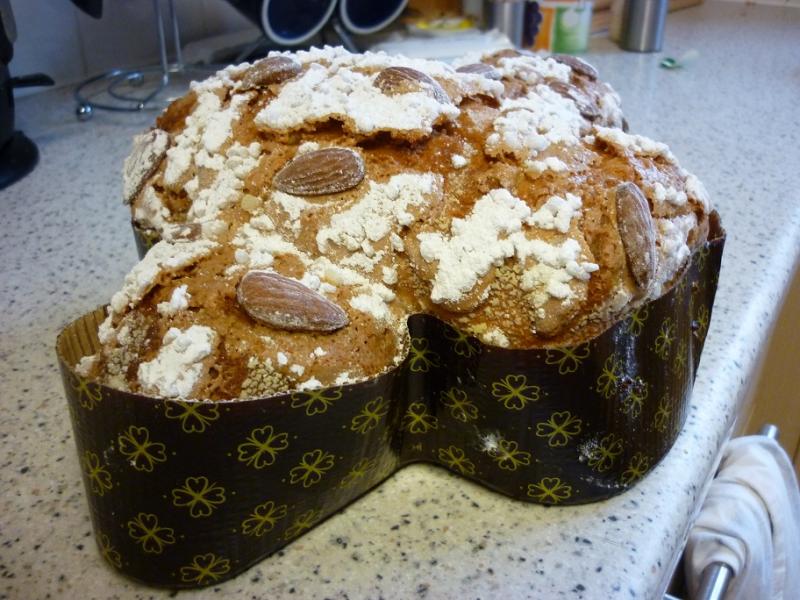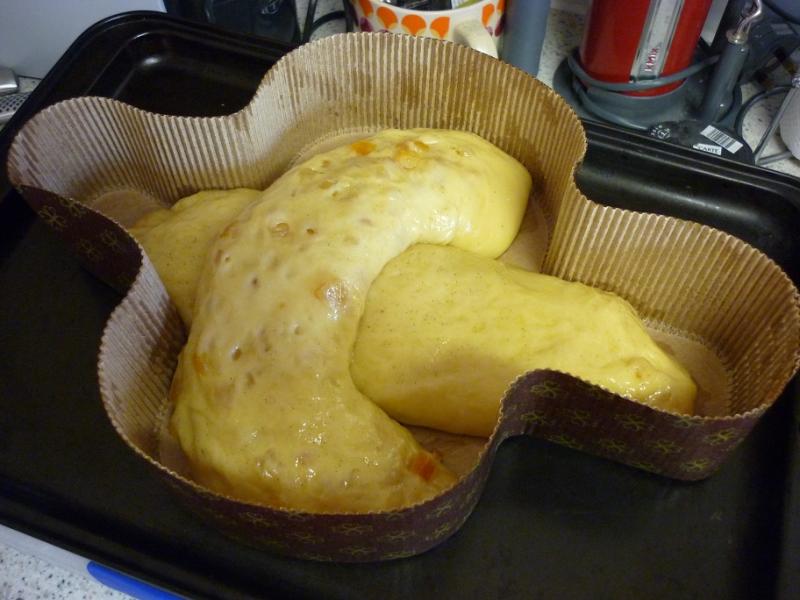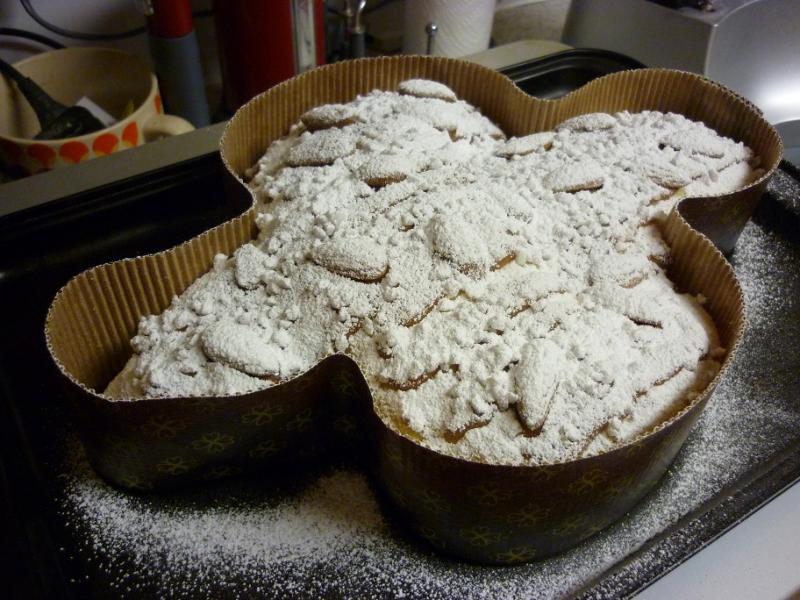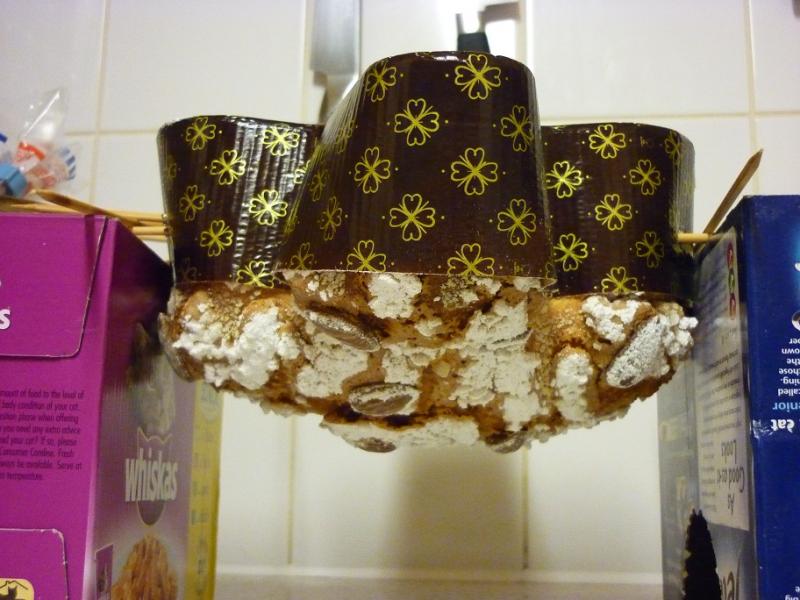I know Easter has passed but I needed yet another challenge...
Here I have made the richest Colomba Pasquale of all. One which comes from Italian master baker and Cresci co-author Achille Zoia.
This was even more challenging than the Iginio Massari Panettone I made recently as this has more fat, more sugar and less water!
I only just managed to pull this off! I had some technical problems along the way but it worked out in the end...
Original recipe calls for a pinch of added yeast but I left this out because my sourdough is so very powerful! As a result, the first dough rose bang on schedule at 12hrs. I also felt there wasn't enough salt, so I doubled it to 4grams instead of the 2grams originally called for.
First dough tripled:
Mixing the second dough was problematic. I think I developed too much strength too early which made incorporating all the butter very tricky and I ended up with a slightly greasy dough that lacked extensibility which made shaping a night-mare as you can see...

Shoddy shaping!
Glazed:
Inverted overnight:
Finished and ready for wrapping. This will mature for a few days to develop its flavours.
Adapted recipe:
First dough:
- 63g Lievito Naturale (Italian sourdough)
- 200g '00' Flour
- 80g Water
- 75g Sugar
- 50g Egg Yolks
- 75g Butter
Second dough:
- 50g '00' Flour
- 50g Egg Yolks
- 38g Sugar
- 25g Honey
- 75g Butter
- 5g Cocoa Butter
- 4g Salt
- Aroma Veneziana
- Seeds from half a Vanilla pod
- 125g Candied Orange Peel
Total Ingredients:
Flour 100.0% 292
Water 34.6% 101
Sugar 38.7% 113
Honey 8.6% 25
Yolks 34.2% 100
Fats 53.1% 155
Fruit 42.8% 125
Salt 1.4% 4
- mwilson's Blog
- Log in or register to post comments
Great,great,great, looks fantastic !
P.S. Can you share the glaze recipe, please ?
Once glazed I covered with whole almonds, nib sugar and then dusted generously with icing (powdered) sugar.
Thank you!
Michael, you are a really GREAT baker. This colomba is one more testimony.
I made this colomba several times, I know it's delicious. Out of curiosity, how long time did you knead the doughs?
Shaping colomba is always a challenge.
Thanks Nico, really means a lot to me!
The first dough mixed for ~30 mins.
Second dough ~1hr plus a few rest intervals of 20 mins before adding the fruit, shaping and dividing.
For the second dough I mix flour and salt to the first and mix until incorporated and then knead by hand until smooth. I then cut this into pieces before putting back in the mixer with a third of the sugar and egg yolks. I have discovered that the early development is important, I just think I over did it a bit. I also added the butter a little hastily too.
Wow, your enriched breads are amazing! Great bake.
Thanks FlourChild.
Cheers hansjoakim. You should certainly try it. I enjoy it more so than panettone.
My Italian style sourdough is pretty amazing stuff. Very powerful!
Michael,
Thanks for posting about this bread. These are the types of breads my daughter loves! Enriched to the max! I have never heard about this bread before so now I have something new to read about.
A question for you...Lately I have been experimenting with holding back the butter when I mix my doughs and you mentioned that you felt like you had developed your dough too much before adding the butter so it ended up being greasy. I have been holding back on the butter to allow the gluten to develop more - read about holding back in Laurel Robertson's Bread Book - and I have been adding in after letting the dough 'rest' for about 60 minutes after the initial mixing in of all the ingredients - like an autolyze but not a true autolyze because I add all the ingredients except add ins and the fat. Now you have me wondering about waiting too long....I seem to end up with a nice smooth dough.
How do you know you waited too long? Is it because the dough was greasy? Couldn't that have been due to all of the butter you were adding? This formula does have a lot of butter added to it...Or did you feel it reach a certain point and then you knew you had gone too far because you had to knead too long and the dough began to degrade due to over kneading?
I guess I shouldn't worry since mine have been turning out okay so far. I just thought it was worth asking because you mentioned something that I am currently experimenting with....something I have only read in a book and the author didn't mention anything about the perils of waiting too long...
Anyway, I think your bread looks wonderful! Thanks for the post and pictures of the process.
Take Care,
Janet
It took me a long time to figure this out but I shall reveal something that probably isn't very well known!
There is over-mixing and there is over-heating.
Over heating is as you would think; a dough too warm from friction. When you get to that point where gluten denatures, you end up with shiny, very sticky, batter-like mixture which cannot be revived. The only option is to chuck it away!
Now over-mixing. Well this means different things to different people but you can mix to much creating an overly tight gluten structure. If this happens you'll find it very hard to make it take on more ingredients.
A dough needs to have good extensibility to take on things like butter and fruit. But of course you need strength too - just not too much! If this happens an autolyse will help and it's what I did to remedy the situation.
Your unlikely to experience the problem I had and have had too many times because my sourdough contributes incredible strength to the gluten structure hence why it can handle a high ratio of weakening ingredients like, sugar and butter.
Consider s & f. Haveyou ever done too many s & f's? Notice how it's hard to shape because it lacks extensibility. Same thing happens when you mix to much. So it's not so much gluten development but more case of highly aligned and overly wrapped up network.
Gluten develops through hydration and this happens over time. Kneading equals gluten aligning!
Hopefully you can understand what took me so long to figure out.
Michael
Michael,
Thanks for these good tips. You have given me lots to pay attention to when I do my mixing and you have put words on things that I have seen but didn't really know how to verbalize.
I have learned tons here from people like you who take the time to explain things - things I probably never would have figured out on my own.
What makes your sourdough so strong? Or, how do know it adds so much strength? Mine seems strong to me - will rise a dough in a couple of hours time - sometime less, and I use only 15% prefermented flour in all of my recipes but I have no idea how it compares to anyone else's sd. I just assumed sd was sd never though of it in terms of how much strength it has.
Thanks again for the pointers.
Take Care,
Janet
Hi Janet.
I know my sourdough contributes a lot of dough strength because I can feel it. All starters have acidity which tightens gluten. With my sourdough I can feel the gluten is very tense (imagine a wet towel twisted - more acidity = more twist).
A firm sourdough will always contribute more strength over a wet starter because of the reduced prtoease activity.
Protease weakens gluten.
Acidity tightens gluten.
Protease activity is significatly reduced in firmer / drier environments.
In terms of yeast activity my sourdough is kept at 28C which is the maximum growth rate for yeast and it's fed 2:1:2 evry 4 hrs and so the population of yeast and L. bacteria is concentrated.
Hope this helps.
Micheal
Michael,
Thanks for this. Gives me a good idea of what you mean by describing the feel of it. I had just thought of strength before as how well a leaven would rise a loaf of bread and now I have a new way of referring to it's strength.
It sounds like your sd is just like mine but I use whole grains, milled fresh right before mixing and I keep mine at a cooler temp. than you do but our refreshment times are the same - I feed every 3 or 4 hours but then at night - the sd that doesn't get used in the day's bread is put into the refrig. with a flour 'blanket' covering it ready for me to use as the seed for builds for the next day's bread. Like yours, it is strong and rises anything I feed to it :-)
Again, thanks for the detailed description!
Take Care,
Janet
Una colomba bellissima! An amazing colomba!
Grazie mille.
And if I was your cat, it would have been consumed in its entirety by now.
-
Just searched for a copy of Cresci.
Only $200 USD!
Thanks Thomas.
For a second there I wondered.. how did you know I have a cat?! But yes, the cat boxes I used to support the dove. The cat on the box looks as if he's eying up that bird!
Cresci is hard to come by and yeah not cheap!
I got it from http://bakerybits.co.uk I don't know how much the shipping will be but probably worth finding out.
Michael
Couldn't resist, sorry.
-
Checked your source for Cresci. It would be 20% less than others I've found, but still not sure I want it that much. Maybe after I buy PH10, which is even more.
Cute!!
gosh, you're going strength to strength in Italian enriched dough-based breads! You can easily start the business selling those online. Seriously.
Thank you!
Selling online is probably something I should definitely do. I would struggle to make more than two at any one time. I'm getting more confident though!
of classic Italian enriched bread. Lovely!
Thanks dabrownman. I do try!